| BrianRxm | Arabic Coins | 6/11 |
Mughal India Coins
Some coins from the Mughal Empire of India
| Prev | Back | Next |
The Mughal Empire was a Islamic kingdom which lasted from AD 1526 to 1857.
Its territory included most of India and part of Afghanistan.
Its capital was Agra (Akbarabad) and briefly Fatehpur Sikri.
Their dynasty was called the "Timurid" dynasty after Timur (AD 1336-1405), the Turko-Mongol
conqueror of much of Asia who was also known as Tamerlane or Timur the Lame.
The Muslim Kalima or statement of faith sometimes appears on Mughal coins in part or whole.
It is "There is no god but Allah and Muhammad is the messenger of Allah."
The coin dates are in Islamic lunar years which start from AD 622 and are 355 days long.
They are abbreviated "AH" and the formula for converting an AH year to an AD year is (AH Year)*0.97 + 622.
The holes in some of the coins are made by silver testers to check the purity of the silver in the coins.
They are called "shroff" marks after the local name for money changers.
Sometimes an inscription will be missing due to being struck off the planchet.
Jahangir: Life: AD 1569-1627 Reign: AD 1605-1627 (AH 1013-1036)
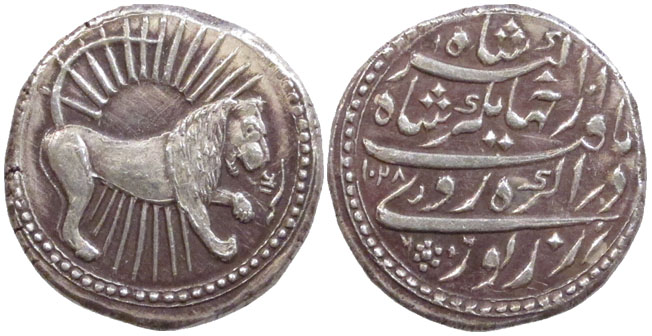
1. Mughal Astrological Sign Leo Coin Copy, Jahangir, Agra, AH 1028 RY 14 (AD 1619)
Silver, 22 mm, 9.82 gm
Obverse: Shining sun and Astrological sign Leo (lion) facing right
Year "14" at right
Reverse: Four horizontal lines of text
Line 1: Shah Akbar
Line 2: Yaft az Jahangir Shah (Gift received from Shah Jahangir) son of (above)
Line 3: Dar Agra Ruye (From Agra ornament)
Line 4: Zar Zewar (Gold money)
This is a modern day copy of a Jahangir gold mohur dated AH 1028 Regnal year 14.
The year "1028" is on the reverse left. AH 1028 is around AD 1619.
The regnal year "14" is on the obverse right.
Year "14" at right
Line 1: Shah Akbar
Line 2: Yaft az Jahangir Shah (Gift received from Shah Jahangir) son of (above)
Line 3: Dar Agra Ruye (From Agra ornament)
Line 4: Zar Zewar (Gold money)
The regnal year "14" is on the obverse right.

2. Mughal Rupee, Jahangir, Jalnapur, No date
Silver, 19 mm, 11.43 gm, minted AD 1605-1608
Obverse: Three horizontal lines of text
Line 1: Ghazi (Fighter for Islam)
Line 2: Jahangir Badshah (Conqueror of the World, Emperor)
Line 3: Nur-ud-din (Light of religion)
Reverse: Two horizontal lines of text
Line 1: "There is no god but Allah"
Line 2: "Muhammad is his messenger" and mint name lower left
Jalnapur is modern Jalna, located 320 km east of Mumbai in Maharashtra state.
Line 1: Ghazi (Fighter for Islam)
Line 2: Jahangir Badshah (Conqueror of the World, Emperor)
Line 3: Nur-ud-din (Light of religion)
Line 1: "There is no god but Allah"
Line 2: "Muhammad is his messenger" and mint name lower left
Shah Jahan: Life: AD 1592-1666 Reign: AD 1628-1658 (AH 1037-1068)
For coins of Shah Jahan please visit Mughal India Coins - Shah Jahan.
Aurangzeb: Life: AD 1618-1707 Reign: AD 1658-1707 (AH 1068-1118)
For coins of Aurangzeb please visit Mughal India Coins - Aurangzeb.
Muhammad Shah: Life: AD 1702-1748 Reign: AD 1719-1748 (AH 1131-1160)
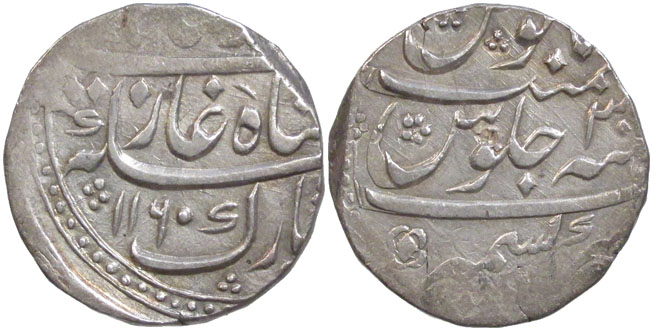
3. Mughal Rupee, Muhammad Shah, Kashmir, AH 1160 RY 30 (AD 1747)
Silver, 23 mm, 11.36 gm
Obverse: Three horizontal lines of text
Line 1: Muhammad Shah (King, this line is outside the flan on this coin)
Line 2: Badshah Ghazi (Emperor and fighter for Islam)
Line 3: Mubarak Sikka 1160 (Auspicious Coin, year 1160)
Reverse: Three horizontal lines of text
Line 1: Manus Sanat (Associated year)
Line 2: Julus Maimanat 30 (Year 30 of his reign associated with tranquil prosperity)
Line 3: Zarb Kashmir (Struck at Kashmir)
The year "1160" is on the obverse below the center. AH 1160 is around AD 1747.
The regnal year "30" is on the reverse at the right.
The Kashmir Mint was located in the city of Srinagar, the capital of Kashmir province.
Line 1: Muhammad Shah (King, this line is outside the flan on this coin)
Line 2: Badshah Ghazi (Emperor and fighter for Islam)
Line 3: Mubarak Sikka 1160 (Auspicious Coin, year 1160)
Line 1: Manus Sanat (Associated year)
Line 2: Julus Maimanat 30 (Year 30 of his reign associated with tranquil prosperity)
Line 3: Zarb Kashmir (Struck at Kashmir)
The regnal year "30" is on the reverse at the right.
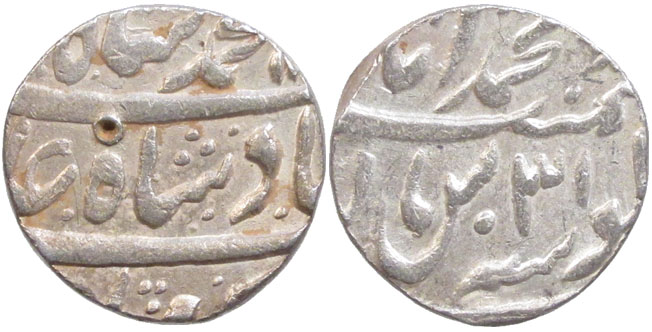
4. Mughal Rupee, Muhammad Shah, Muhammadabad-Banaras, AH 1161 RY 31 (AD 1748)
Silver, 15 mm, 11.35 gm
Obverse: Three horizontal lines of text
Line 1: Muhammad Shah (King)
Line 2: Badshah Ghazi (Emperor and fighter for Islam)
Line 3: Mubarak Sikka (Auspicious Coin, this line is outside the flan on this coin)
Reverse: Three horizontal lines of text
Line 1: Zarb Muhammadabad (Struck Muhammadabad)
Line 2: Manus Sanat Julus Maimanat 31 (Year 31 of his reign associated with tranquil prosperity)
Line 3: Banaras (this line is outside the flan on this coin
The coin has no year visible.
The regnal year "31" is on the reverse center right.
Muhammadabad-Banaras was a mint located in what is now Benares or Varanasi.
Varanasi is a city in the state of Uttar Pradesh located in northern India.
Line 1: Muhammad Shah (King)
Line 2: Badshah Ghazi (Emperor and fighter for Islam)
Line 3: Mubarak Sikka (Auspicious Coin, this line is outside the flan on this coin)
Line 1: Zarb Muhammadabad (Struck Muhammadabad)
Line 2: Manus Sanat Julus Maimanat 31 (Year 31 of his reign associated with tranquil prosperity)
Line 3: Banaras (this line is outside the flan on this coin
The regnal year "31" is on the reverse center right.
Varanasi is a city in the state of Uttar Pradesh located in northern India.
Ahmad Shah Bahadur: Life: AD 1725-1775 Reign: AD 1748-1754 (AH 1160-1167)
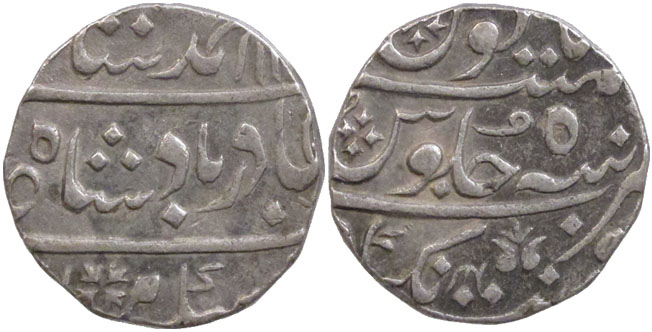
5. Mughal Rupee, Ahmad Shah Bahadur, Balwantnagar, AH 11xx RY 5 (AD 1752-1753)
Silver, 22 mm, 11.34 gm
Obverse: Three horizontal lines of text
Line 1: Ahmad Shah (Ahmad King)
Line 2: Bahadur Badshah Ghazi (Brave, Emperor, Fighter for Islam)
Line 3: Mubarak Sikka (Auspicious Coin)
Reverse: Three horizontal lines of text
Line 1: Manus Maimanat (Tranquil prosperity associated with)
Line 2: Sanat 5 Julus (Year 5 of his reign)
Line 3: Zarb Balwantnagar (Struck Balwantnagar)
(Struck Balwantnagar in year 5 of his reign associated with tranquil prosperity)
The year "11xx" is on the obverse top right.
The regnal year first digit "5" is on the reverse right.
Ahmad Shah Bahadur's official accession date was AH 1161, fifth month, first day or 1161-5-1.
The regnal year ran from 1165-5-1 to 1166-4-29, thus the coin was struck in either of those two years.
Balwantnagar is a city in the Indian state of Uttar Pradesh and is now known as Jhansi.
Line 1: Ahmad Shah (Ahmad King)
Line 2: Bahadur Badshah Ghazi (Brave, Emperor, Fighter for Islam)
Line 3: Mubarak Sikka (Auspicious Coin)
Line 1: Manus Maimanat (Tranquil prosperity associated with)
Line 2: Sanat 5 Julus (Year 5 of his reign)
Line 3: Zarb Balwantnagar (Struck Balwantnagar)
(Struck Balwantnagar in year 5 of his reign associated with tranquil prosperity)
The regnal year first digit "5" is on the reverse right.
Ahmad Shah Bahadur's official accession date was AH 1161, fifth month, first day or 1161-5-1.
The regnal year ran from 1165-5-1 to 1166-4-29, thus the coin was struck in either of those two years.
Shah Alam II: Life: AD 1728-1806 Reign: AD 1759-1806 (AH 1173-1221)

6. Mughal Rupee, Shah Alam II, Shahjahanabad, AH 1199 RY 27 (AD 1785)
Silver, 21.0 mm, 11.29 gm
Obverse: Three horizontal lines of text
Line 1: Shah Alam, Emperor
Line 2: Under the the Shadow of the Grace of God, Defender of the Religion of Mohammed (11)99
Line 3: Money he struck through the seven climes
Reverse: Two horizontal lines of text
Line 1: Dar-ul-Khilafat (Seat of Government), Shahjahanabad
Line 2: Struck in year 27 of the accession associated with tranquil prosperity
The year "1199" is on the obverse left. AH 1199 is around AD 1785.
The regnal year "27" is on the reverse bottom.
Shahjahanabad was the name for the Mughal capital at Delhi.
Line 1: Shah Alam, Emperor
Line 2: Under the the Shadow of the Grace of God, Defender of the Religion of Mohammed (11)99
Line 3: Money he struck through the seven climes
Line 1: Dar-ul-Khilafat (Seat of Government), Shahjahanabad
Line 2: Struck in year 27 of the accession associated with tranquil prosperity
The regnal year "27" is on the reverse bottom.

7. Mughal Rupee, Shah Alam II, Saharanpur, AH 1208 RY 34 (AD 1794)
Silver, 22.0 mm, 11.21 gm
Obverse: Three horizontal lines of text
Line 1: Shah Alam, Emperor
Line 2: Under the the Shadow of the Grace of God, Defender of the Religion of Mohammed (1)208
Line 3: Money he struck through the seven climes
Reverse: Two horizontal lines of text
Line 1: Dar-ul-Sarur (Seat of Delight), Saharanpur, Dar-ul-Khilafat (Seat of Government)
Line 2: Struck in year 34 of the accession associated with tranquil prosperity
The year "1208" is on the obverse left. AH 1208 is around AD 1794.
The regnal year "34" is on the reverse bottom.
This coin was struck by the Maratha Empire which used Shah Alam II as a front.
Saharanapur is about 100 miles north of Delhi.
Line 1: Shah Alam, Emperor
Line 2: Under the the Shadow of the Grace of God, Defender of the Religion of Mohammed (1)208
Line 3: Money he struck through the seven climes
Line 1: Dar-ul-Sarur (Seat of Delight), Saharanpur, Dar-ul-Khilafat (Seat of Government)
Line 2: Struck in year 34 of the accession associated with tranquil prosperity
The regnal year "34" is on the reverse bottom.
Saharanapur is about 100 miles north of Delhi.
Tipu Sultan: Life: AD 1751-1799 Reign: AD 1782-1799 (AH 1196-1213)
Tipu Sultan was the Moslem ruler of the Indian Kingdom of Mysore from 1782 to 1799.
Mysore is located in south west India and is next to the Malabar coast.
Tipu Sultan was officially a vassal of the Mughal Emperor Shah Alam II but acted independently.
He was continually at war with the British East India Company (The Company).
In the 1780's and 1790's his army used rockets manufactured in Bangalore to fight the British.
The British copied the rockets and used them against their enemies.

8. India Mysore Paisa, Tipu Sultan, Farrukhi, Mauludi 1217 (AD 1788)
Copper, 24x26 mm, 10.92 gm
Obverse:
Elephant facing left, year 7121 (1217)
Reverse:
Persian: Struck at Farrukhi
The year "1217" is on the obverse top.
Tipu Sultan used the Mauludi solar dating system where year 1 was AD 572,
one year after the birth of the Prophet Mohammed.
Mauludi 1217+572-1 is AD 1788.
Farrukhi was Tipu Sultan's capital in Malabar established in AD 1788.
It was located near the city of Calicut (not Calcutta).
He established his mint there and the city was also known as Farrukhabad (hyab).
Elephant facing left, year 7121 (1217)
Persian: Struck at Farrukhi
Tipu Sultan used the Mauludi solar dating system where year 1 was AD 572,
one year after the birth of the Prophet Mohammed.
Mauludi 1217+572-1 is AD 1788.
It was located near the city of Calicut (not Calcutta).
He established his mint there and the city was also known as Farrukhabad (hyab).

9. India Mysore Half Paisa, Tipu Sultan, Farrukhyab-Hisar, Mauludi 1217 (AD 1788)
Copper, 18 x 20 mm, 5.60 gm
Obverse:
Elephant facing left, year 7121 (1217)
Reverse:
Persian: Struck at Farrukhyab-Hisar
Elephant facing left, year 7121 (1217)
Persian: Struck at Farrukhyab-Hisar
Wajid Ali Shah: Life: AD 1822-1887 Reign: AD 1847-1856 (AH 1263-1272)
Post-Mughal Awadh Province
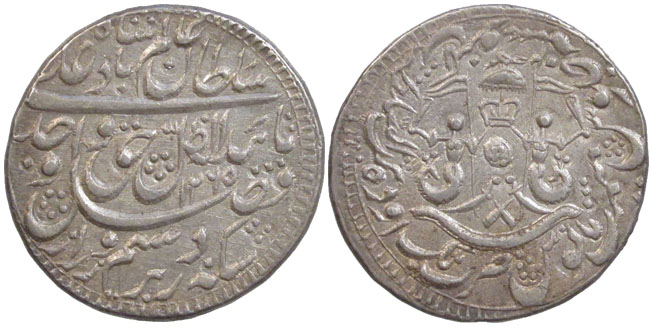
10. Post-Mughal Rupee, Wajid Ali Shah, Awadh Province, Lucknow, AH 1265 RY 2 (AD 1849)
Silver, 25.0 mm, 11.13 gm
Awadh Sultan or King Wajid Ali Shah AD 1847-1856
Mint: Lucknow (Lucknow is a city in the state of Uttar Pradesh in northern India)
Obverse: (Some of the words are not in order)
Zill Hazz Wajid Ali Sultan Alam Badshah
(Shadow of the True One, Wajid Ali Shah, Sultan of the World, Emperor)
Sikka Zad Bar Sim Wa Zar Fazi Wa Ta'id Ilah
(Struck coin on silver and gold by the grace and help of God)
The year "1265" is on the obverse right of center. AH 1265 is around AD 1849
Reverse:
European style coat of arms in center with two mermaids holding flags and supporting a crown
and a parasol with a bird perched on top.
Below are a shield, two swords, and two clubs. At the bottom is a snake.
Legend around the coin:
Zarb Mulk Awadh Bait Al-Sultanat Lakhnau Sanat 2 Jalus Maimanat Manus
Struck at Awadh, House of the Sultanate, Lucknow in year 2 of his reign associated with prosperity
(Note: The same slogan was used by the Mughal emperor Aurangzeb)
Awadh Sultan or King Wajid Ali Shah AD 1847-1856
Mint: Lucknow (Lucknow is a city in the state of Uttar Pradesh in northern India)
Zill Hazz Wajid Ali Sultan Alam Badshah
(Shadow of the True One, Wajid Ali Shah, Sultan of the World, Emperor)
Sikka Zad Bar Sim Wa Zar Fazi Wa Ta'id Ilah
(Struck coin on silver and gold by the grace and help of God)
European style coat of arms in center with two mermaids holding flags and supporting a crown
and a parasol with a bird perched on top.
Below are a shield, two swords, and two clubs. At the bottom is a snake.
Zarb Mulk Awadh Bait Al-Sultanat Lakhnau Sanat 2 Jalus Maimanat Manus
Struck at Awadh, House of the Sultanate, Lucknow in year 2 of his reign associated with prosperity
(Note: The same slogan was used by the Mughal emperor Aurangzeb)
Wajid Ali Shah was the last Nawab (King) of Awadh which was also known as "Oudh."
Awadh is located in northern India and was one of the richest provinces.
Wajid Ali Shah was a Shia Muslim but most of his subjects were Hindu.
During his reign the British had control over the province and in 1856 they fired the Nawab,
sent him to Calcutta with a pension, and took direct control of Awadh.
Many Indian soldiers in the British army were from Awadh and the sacking of the Nawab was one of
the reasons they began a troop mutiny in 1857.
| Prev | Back | Next |